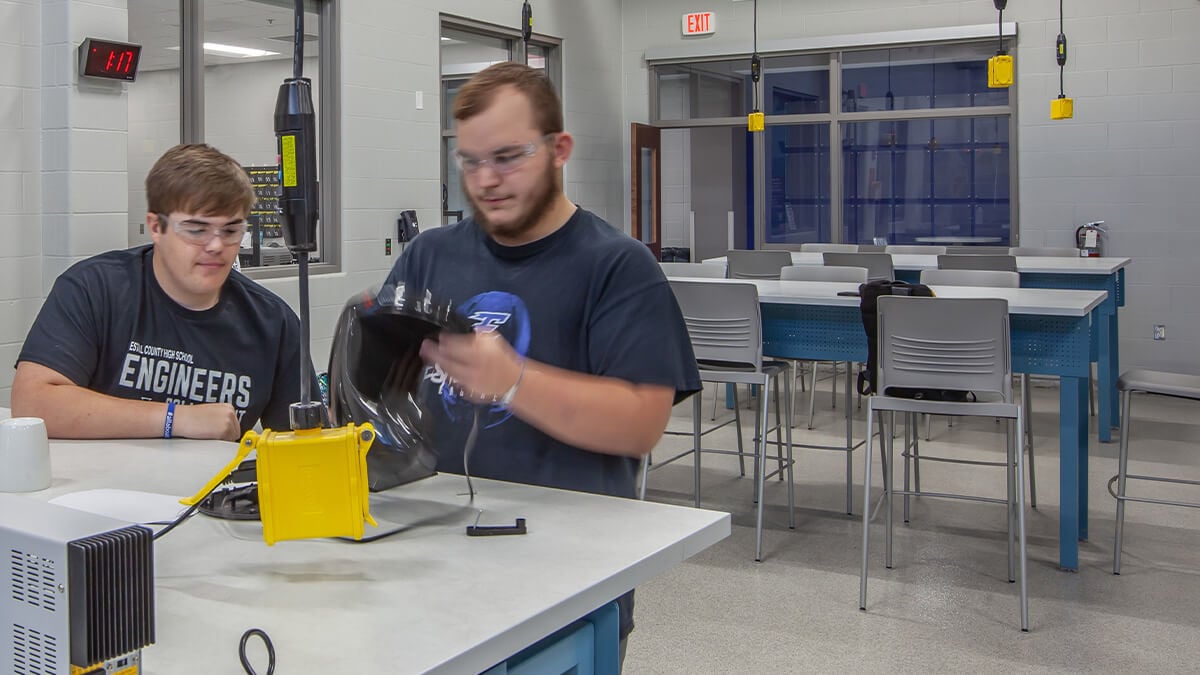- What's New
- Pricing & Purchasing
- Lead Times
- Literature & Samples
- Services & Warranties
- Careers
- Find a Rep
Five Trends Shaping Education in 2024

Explore the future of learning as we reveal five pivotal trends set to reshape the educational landscape—from addressing burnout to elevating the importance of STEM classes.
Looking ahead to the educational landscape of 2024, we predict several key trends will shape the future of K-12 and higher education.
With a heightened commitment to well-being, we’re sure to see greater acknowledgment and support for mental health issues among students and educators. Additionally, an increased focus on innovation and entrepreneurship will help students prepare for a technology-driven future. And similarly, we’ll find a diversification of educational and career paths beyond traditional four-year universities.
To better engage students in learning, we’ll continue to see advancement in personalized learning approaches. To that end, a rise in esports will take center stage, bridging students' passion for gaming with STEM skill-building.
Altogether, these trends reflect a comprehensive effort to create a balanced, innovative, and inclusive educational environment. Let’s dive into the details.
1. A Renewed Commitment to Well-Being
Students from middle school through college are struggling with record-high rates of anxiety, depression, loneliness, and suicidal ideation. Middle and high schoolers say their biggest barrier to learning is stress, anxiety, or depression. A Healthy Minds survey found that 44% of college students reported symptoms of depression. The same survey data also shows an increase in students seeking counseling and therapy at the highest rate since 2018 -- a positive update in a sea of disheartening news.
Social isolation, academic pressure, and social media use are suspected contributors to this mental health crisis. Schools, colleges, and universities are working to counteract this with initiatives to prioritize mental health, from anti-bullying campaigns and phone-free spaces to calming rooms for students who want to self-regulate in a safe haven. They’re also focusing on creating a sense of belonging and community, which has a powerful impact on student well-being, engagement, and achievement.
For educators, burnout has been showing up in record-high levels of turnover, both for K-12 teachers as well as faculty, staff, and even presidents at the college level. Educators are more likely to report depression and job-related stress compared to other adults. We know from experience that one of the best ways to support educators, no matter what grade level they teach, is by protecting their time and giving them opportunities for growth without stretching them too thin.
2. Increased Focus on Innovation and Entrepreneurship
Students need to know a lot more than reading, writing, and arithmetic to thrive in today’s world. Employers cite “power skills” like problem-solving, interpersonal communication, leadership, and creativity as the most important skills they want to see in a new employee. As a result, we’re seeing educators incorporate these life skills and entrepreneurial practices into the curriculum. These skills have for a long time been mislabeled as “soft skills,” but they’re foundational to student success in school, work, and relationships.
In 2024 and beyond, we’ll continue to see a large focus on skills that prepare students for a technology-oriented future. Expect schools in both K-12 and higher education to devote more resources to programs in computer science, STEM and STEAM, design thinking, AI, and VR.
3. Preparing Students for All Futures
Roughly 43% of high school graduates will attend a four-year university and less than two-thirds of those students will graduate from college within six years. We’ve long known that traditional paths to four-year colleges don’t serve a majority of students. Schools are shifting gears to spotlight additional educational and workforce opportunities, from vocational and trade schools to technical certificates and partnerships between companies and technical colleges or high schools.
At its core, this trend is about diversifying the idea of what success looks like. Students need to know they have a wide variety of educational and career options that fit their skills and goals. High schools can help by devoting resources to counseling students about all the options they can pursue after graduating, as well as supporting educational workshops, career fairs, and internship or career shadowing programs.
4. Personalized Learning to Boost Engagement
Eighty percent of teachers say they’re worried about student engagement. Whether it’s because of distractions from phones or external stressors, many students of all ages aren’t fully present and alert at school. In the same survey of teachers, 65% of respondents said that leveraging students’ personal interests and passions within learning is a highly effective way to boost student engagement.
Students learn in a million different ways, and educators are responding to this by including a variety of opportunities within the curriculum to appeal to a student’s learning style. That might look like offering group work, partner work, or remote and technology-friendly options for some lesson plans. We’ll also likely see an expansion of student-guided learning models like self-pacing or interest-based learning, two frameworks that recognize students learn best when they’re given agency and excited about the subject matter.
5. Esports Take Center Stage
The esports industry, centered on competitive multiplayer video games, is booming. Globally, the esports market is expected to be valued at $4.7 billion by 2030. Colleges are taking note.
Colleges like Miami University in Ohio and the University of California at Irvine even have varsity esports programs and offer scholarships. Schools and businesses see an opportunity to foster students’ passions for video games while encouraging learning and skill-building in STEM, which can prepare students for careers in IT, computer science, software engineering, game design and development, and more.
Right now, the esports boom is more formalized in higher education, but we’re already seeing it permeate into K-12 education, with school districts across the country designing for esports arenas and other gaming spaces.
What Trends Are You Watching in 2024?
Across these trends in education, a few key themes stand out. Students need balance to reach their academic and social potential. This means a mixture of work and play, rest and learning, group work and independent study. K-12 schools and colleges are working to create flexible learning environments that support students’ health and freedom, inside and outside the classroom.
What changes are you seeing in your school, your child’s school, or more broadly in education? Reach out to me at bryan.ballegeer@ki.com to share your thoughts!
Related Content
 Blog
Blog
From financial aid to fluctuating enrollment, discover the critical changes and challenges impacting higher education this academic year.
 Blog
Blog
Former teacher and principal Emily McGinnis shares how to support educators who are feeling burned out and reflects on the importance of listening to teachers.
 Blog
Blog
Less than one-third of high school graduates will receive a four-year college degree. By dedicating resources to career and technical education, we can set up all students for success.
Subscribe
Stay up to date with the latest trends and more.

















